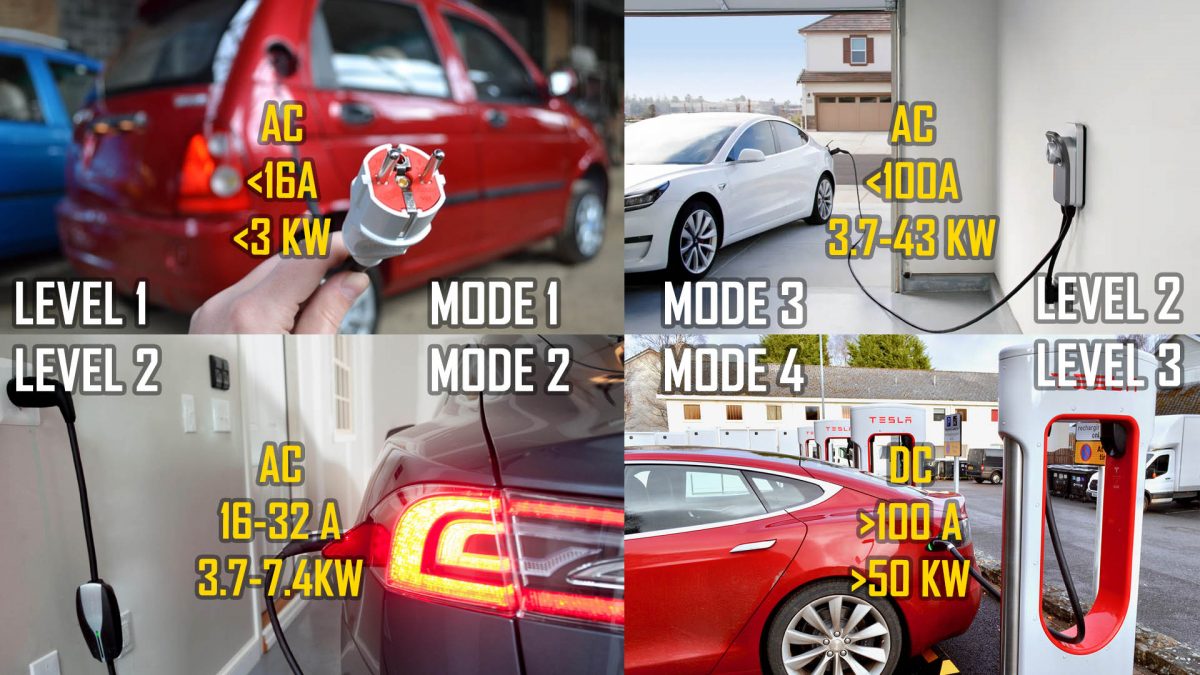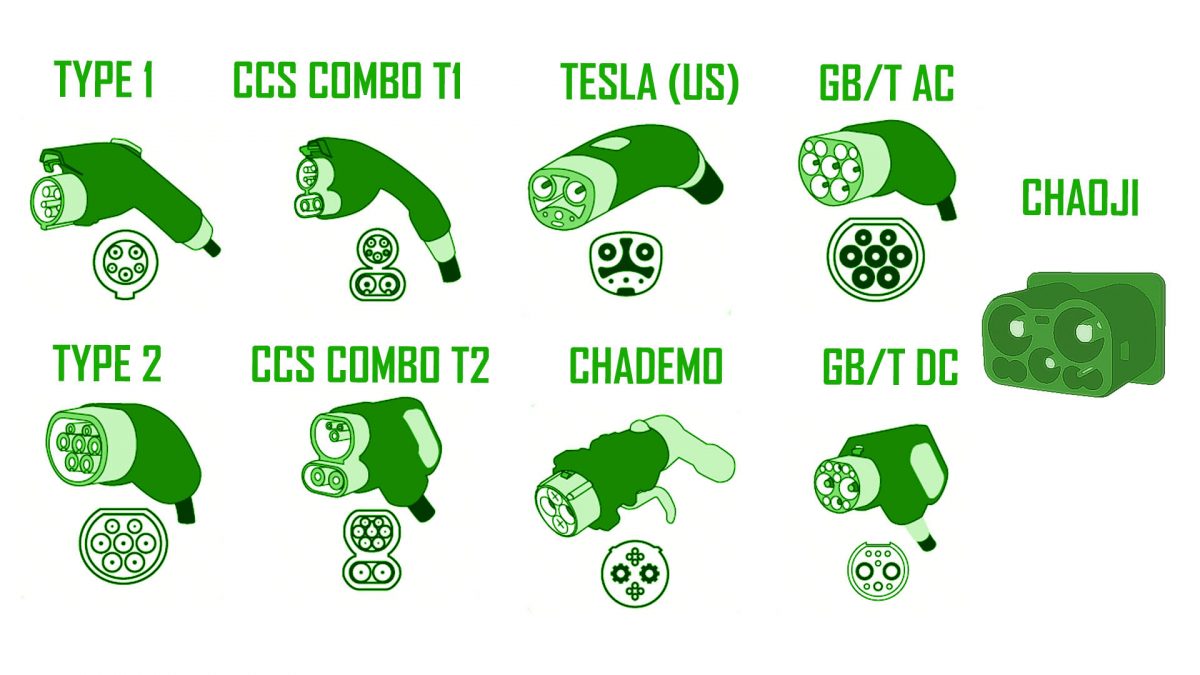EV Chargers, Cables and Connectors for Electric Car Charger
First thing, that every EV owner must have – right cable connector and chargers nearby. No matter what it would be: electrical socket inside home, wall fast charger or powerful rapid charger nearby. An Ultimate Guide to Electric Vehicle Charging for newbies below.
Contents:
Chargers by Modes
Types of Plug Connectors
What Chargers do your electric car use?
Slow, Fast and Rapid chargers’ stations
How Long Does It Take to Charge different EV list
Video EV Charging Basics
Modes of charging according to the world standards
There are four modes of charging, that differs from one to another by current type, voltage, and power delivery capability. We describe it from lower to higher charging speed.
Mode 1 (AC Level 1)
The slowest type of charging carried out mainly from you home network. The charging time interval of the electric vehicle by this method is approximately 12 hours (depends on battery capacity). The process takes place without special equipment, with a standard socket and a special AC adapter. Today this type is practically not used for charging EVs due to the low security of connections.
Mode 2 (AC Level 2)
Standard type of AC charging station, which can be used at home or at service stations. It is used for charging electric vehicles of all types with traditional connectors with a protection system inside the cable. The charging time is about 7-8 hours with storage capacity for batteries with capacity near 19-25 kWh. Tesla Model 3 will charge near 20 hours.
Mode 3 (AC Level 2)
The most powerful mode used in AC stations. Type 1 connectors are used for single-phase and Type 2 connectors for three-phase electric power. If you want to use Mode 3 at home, you need to buy additional equipment: wall or outdoor charging station. Also 3 phase socket and higher current rating required. The charging time for EV with batteries 50-80 kWh decreases to 9-12 hours.
Mode 4 (DC Level 1-2)
Charging stations Mode 4 use direct current instead of alternating. The power of such complexes is too high for some electric vehicles. For those who support this standard, batteries are charged up to 80% within 30 minutes. Such charging complexes can be found in urban parking lots and highways, because the development of such a complex requires a separate high-power power line. Besides, the price of this charging station is quite high.
When you are looking for EV chargers for home, be sure that your car supports fast charge. This information can be found on the manufacturer documentation.
EV Charging Connector Types
There is no single standard for EV charging plugs in world. Besides, difference between car manufacturers, also Europe, North America and Asia has own standards.
Tesla Supercharger
World’s most big EV manufacturer use own type of charging connectors called Tesla Supercharger. This plug type also differs for North America and another world (Europe for example). Connector support AC charging Mode 2, Mode 3, and DC fast charge (Mode 4).
Also, you can use CHAdeMO or CCS Combo with adapters. This make port generalized use, no matter where and when you go.
Type 2 (Mennekes)
The 7-pin charging connector plug mainly used for electric vehicles made for Europe as well as several Chinese cars that have been adapted. The peculiarity of the connector consists in the possibility of using a single-phase and three-phase network, with a maximum voltage of 400V, a current of 63A, and a power of 43 kW. Usually 400 volts and 32 amperes with maximum output power 22 kW for three-phase connection and 230 volts 32 amperes and 7.4 kilowatts for one-phase connection. The connector allows the use of charging stations with Mode 2 and Mode 3.
Type 1 (knows as SAE J1772 or J-plug)
The 5-pin standard electric-mobile connector common to most American and Asian electric vehicles. It used but all EV manufacturers except Tesla. The Type 1 plug is used for charging an electric vehicle from charging complexes according to Mode 2 and Mode 3 standards. Charging takes place by means of a single-phase AC power grid with a maximum voltage of 230V, a current of 32A and a power limit of 7.4 kW.
CCS Combo (Type 1/Type 2)
A combined connector type that allows you to use both slow and fast charging points. The connector can be operated due to inverter technology that converts DC to AC. Vehicles with this type of connection can take the charging speed up to the maximum «rapid» charge.
The CCS Combo connectors are not the same for Europe and the US and Japan: for Europe, Combo 2 connectors are compatible with Mennekes, and for the US and Japan, Combo 1 compatible with J1772 (Type 1). The CSS Combo is designed to charge 200-500 volts at 200 amperes and power 100 kW. CSS Combo 2 is currently the most common type of connector in fast charging stations in Europe.
CHAdeMO
The 2-pin DC connector was developed with the cooperation of major Japanese automakers with TEPCO. It can be used to charge most Japanese, American and several European electric vehicles. It is designed for use in powerful DC charging stations in Mode 4 to charge up the battery to 80% in 30 minutes (at power of 50 kW). It is designed for a maximum voltage of 500V and a current of 125A with a power of up to 62.5 kW, but already the characteristics are significantly increased.
ChaoJi
Upcoming plug standard ChaoJi is nothing but an evolution of CHAdeMO (3rd generation). It can charge supported cars with DC of 600A and power of up to 500 kW. Connector support previous standards of CHAdeMO, GB/T or even CCS with adapter.
GB/T
This standard is unique to Chinese-made cars and is often referred to as simply GBT. Visually, it almost resembles the European Mennekes, but is not technically compatibility to it. There are two types of connectors for this standard, one for the slow (AC) second for fast charging (DC).
List of most common EV cars and their supported ports and chargers (updateable)
| EV name | Type 1 / 2 | CCS Combo | CHAdeMO | Tesla Supercharger | Rapid Charging |
|---|
| Tesla Model S, 3, X, Y | Yes | Yes | Yes | Yes | Yes |
| Hyundai Ioniq Electric | Yes | Yes | No | No | Yes |
| Hyundai Kona Electric | Yes | Yes | No | No | Yes |
| Chevrolet Bolt EV (Opel Ampera-E) | Yes | Yes | No | No | Yes |
| Chevrolet Spark EV | Yes | Yes | No | No | Yes |
| Fiat 500e | Yes | No | No | No | No |
| Jaguar I-Pace | Yes | Yes | No | No | Yes |
| Kia Soul EV | Yes | No | Yes | No | Yes |
| Mercedes-Benz B-Class Electric | Yes | No | No | No | No |
| Mitsubishi i-MiEV | Yes | No | Yes | No | Yes |
| Renault Zoe | Yes | No | No | No | No |
| Renault Kangoo Z.E. | Yes | No | No | No | No |
| Nissan Leaf | Yes | Yes | Opt. | No | Yes |
| Nissan e-NV200 | Yes | No | Opt. | No | Yes |
| Volkswagen e-Golf | Yes | Yes | No | No | Yes |
Post time: Apr-17-2021







